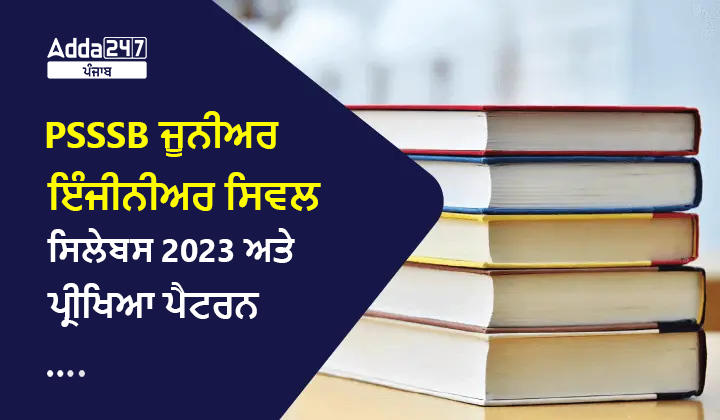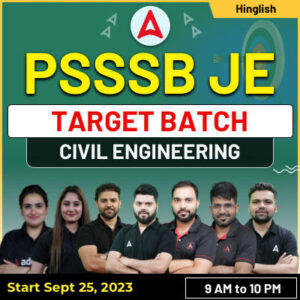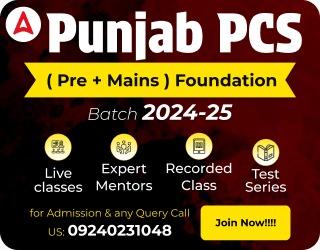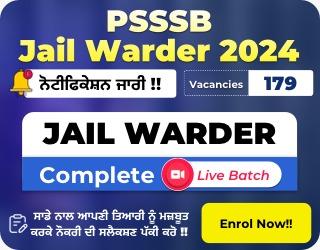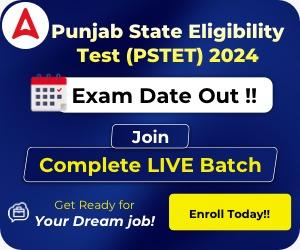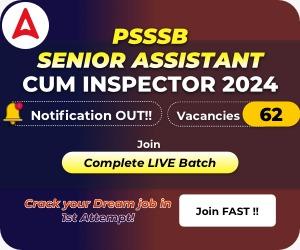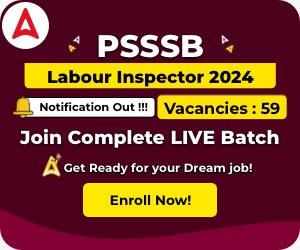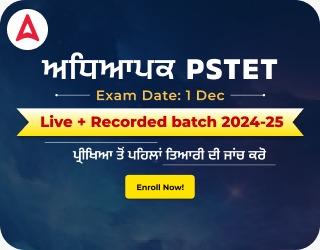PSSSB ਜੂਨੀਅਰ ਇੰਜੀਨੀਅਰ ਸਿਵਲ ਸਿਲੇਬਸ 2023: PSSSB ਭਰਤੀ 2023 ਦੇ ਤਹਿਤ ਜੂਨੀਅਰ ਇੰਜੀਨੀਅਰ ਸਿਵਲ ਲਈ ਕੁੱਲ 257 ਅਸਾਮੀਆਂ ਜਾਰੀ ਕੀਤੀਆਂ ਹਨ। ਇਸ ਲੇਖ ਵਿੱਚ PSSSB ਜੂਨੀਅਰ ਇੰਜੀਨੀਅਰ ਸਿਵਲ ਪ੍ਰੀਖਿਆ 2023 ਲਈ ਸਿਲੇਬਸ, ਇਮਤਿਹਾਨ ਪੈਟਰਨ, PDF, ਟਿਪਸ ਅਤੇ ਟ੍ਰਿਕਸ ਬਾਰੇ ਪੂਰੀ ਜਾਣਕਾਰੀ ਸ਼ਾਮਲ ਹੈ। ਆਓ PSSSB ਜੂਨੀਅਰ ਇੰਜੀਨੀਅਰ ਸਿਵਲ ਸਿਲੇਬਸ ਅਤੇ ਪ੍ਰੀਖਿਆ ਪੈਟਰਨ 2023 ਨੂੰ ਇੱਕ ਇੱਕ ਕਰਕੇ ਇਸ ਦੇ ਸਾਰੇ ਕਦਮ ਸਮਝੀਏ।
PSSSB ਜੂਨੀਅਰ ਇੰਜੀਨੀਅਰ ਸਿਵਲ ਸਿਲੇਬਸ 2023 ਅਤੇ ਪ੍ਰੀਖਿਆ ਪੈਟਰਨ ਸੰਖੇਪ ਜਾਣਕਾਰੀ
PSSSB ਜੂਨੀਅਰ ਇੰਜੀਨੀਅਰ ਸਿਵਲ ਸਿਲੇਬਸ 2023: ਜਿਹੜੇ ਉਮੀਦਵਾਰ ਜੂਨੀਅਰ ਇੰਜੀਨੀਅਰ ਸਿਵਲ JE ਪ੍ਰੀਖਿਆ 2023 ਲਈ ਅਰਜ਼ੀ ਦੇ ਰਹੇ ਹਨ, ਉਨ੍ਹਾਂ ਨੂੰ ਰਿਵਾਇਸਡ ਸਿਲੇਬਸ ਅਤੇ ਪ੍ਰੀਖਿਆ ਪੈਟਰਨ ਬਾਰੇ ਪਹਿਲਾਂ ਤੋਂ ਪਤਾ ਹੋਣਾ ਚਾਹੀਦਾ ਹੈ। ਇਹ ਤੁਹਾਨੂੰ PSSSB ਜੂਨੀਅਰ ਇੰਜੀਨੀਅਰ ਸਿਵਲ ਪ੍ਰੀਖਿਆ 2023 ਦੀ ਤਿਆਰੀ ਕਰਨ ਵਿੱਚ ਮਦਦ ਕਰੇਗਾ। ਹੇਠਾਂ ਦਿੱਤੀ ਸਾਰਣੀ ਵਿੱਚ ਦਿੱਤੇ ਸੰਖੇਪ ਜਾਣਕਾਰੀ ਦੀ ਜਾਂਚ ਕਰੋ ਉਮੀਦਵਾਰ ਇਸ ਪੇਪਰ ਦੀ ਸਾਰੀ ਜਾਣਕਾਰੀ ਹੇਠਾਂ ਟੇਬਲ ਵਿੱਚੋਂ ਦੇਖ ਸਕਦੇ ਹਨ। ਜਿਵੇਂ ਕੇ ਪੇਪਰ ਵਿੱਚ ਕੀ ਪੈਟਰਨ ਆਵੇਗਾ, ਸਿਲੇਬਸ ਵਿੱਚ ਕਿਹੜੇ ਕਿਹੜੇ ਵਿਸ਼ੇ ਆਉਣਗੇ। ਉਮੀਦਵਾਰ ਨੂੰ ਸਲਾਹ ਦਿੱਤੀ ਜਾਂਦੀ ਹੈ। ਕਿ ਉਹ ਸਮੇਂ ਸਮੇਂ ਤੇ ਇਸ ਲੇਖ ਨੂੰ ਦੇਖਦੇ ਰਹਿਣ।
| PSSSB ਜੂਨੀਅਰ ਇੰਜੀਨੀਅਰ ਸਿਵਲ ਸਿਲੇਬਸ 2023 ਅਤੇ ਪ੍ਰੀਖਿਆ ਪੈਟਰਨ: ਸੰਖੇਪ ਜਾਣਕਾਰੀ | |
| ਭਰਤੀ ਬੋਰਡ |
ਪੰਜਾਬ ਅਧੀਨ ਸੇਵਾ ਚੋਣ ਬੋਰਡ
|
| ਪੋਸਟ ਨਾਮ |
ਜੂਨੀਅਰ ਇੰਜੀਨੀਅਰ ਸਿਵਲ (JE)
|
| ਪੋਸਟਾਂ | 257 |
| ਕੈਟਗਰੀ | |
| What’s App Channel Link | Join Now |
| Telegram Channel Link | Join Now |
| ਅਧਿਕਾਰਤ ਸਾਈਟ | @sssb.punjab.gov.in |
PSSSB ਜੂਨੀਅਰ ਇੰਜੀਨੀਅਰ ਸਿਵਲ ਅਤੇ ਜਨਤਕ ਸਿਹਤ ਸਿਲੇਬਸ 2023
PSSSB ਜੂਨੀਅਰ ਇੰਜੀਨੀਅਰ ਸਿਵਲ ਸਿਲੇਬਸ 2023: ਜੋ ਉਮੀਦਵਾਰ JE ਪ੍ਰੀਖਿਆ 2023 ਵਿੱਚ ਹਾਜ਼ਰ ਹੋ ਰਹੇ ਹਨ, ਉਹ ਉਮੀਦਵਾਰ ਜੂਨੀਅਰ ਇੰਜੀਨੀਅਰ ਇਲੈਕਟਰੀਕਲ, ਜੂਨੀਅਰ ਇੰਜੀਨੀਅਰ ਸਿਵਲ ਅਤੇ ਜੂਨੀਅਰ ਇੰਜੀਨੀਅਰ ਜਨਤਕ ਸਿਹਤ ਸਿਲੇਬਸ 2023 ਵੇਖ ਸਕਦੇ ਹਨ। ਉਮੀਦਵਾਰ PSSSB ਜੂਨੀਅਰ ਇੰਜੀਨੀਅਰ ਸਿਵਲ JE ਪੇਪਰ 2023 ਦੀ ਤਿਆਰੀ ਲਈ ਸਿਲੇਬਸ ਦੀ ਜਾਂਚ ਕਰ ਸਕਦੇ ਹਨ। PSSSB ਜੂਨੀਅਰ ਇੰਜੀਨੀਅਰ ਸਿਵਲ JE ਪ੍ਰੀਖਿਆ 2023 ਵਿੱਚ ਸ਼ਾਮਲ ਸਾਰੇ ਵਿਸ਼ੇ ਹੇਠਾਂ ਦਿੱਤੇ ਗਏ ਹਨ। ਉਮੀਦਵਾਰ ਹੇਠ ਲਿਖੇ ਵਿਸ਼ੇ ਨੂੰ ਦੇਖੋ:
| PSSSB Junior Engineer Civil Syllabus 2023 | ||
| Sr. No. | Indicative Contents of Syllabus | The weightage (Approx.) |
| 1 | General Knowledge and Current Affairs of National and International Importance Including:
|
10 |
| 2 | Punjab History and Culture- Physical features of Punjab and its ancient history. Social, religious, and economic life in Punjab. Development of Language & Literature and Arts in Punjab, Social and Culture of Punjab during Afgan/Mughal Rule, Bhakti Movement, Sufism, Teachings/History of Sikh Gurus and Saints in Punjab. Adi Granth, Sikh Rulers, Freedom movements of Punjab. |
5 |
| 3 | Logical Reasoning & Mental Ability:
|
10 |
| 4 | ਪੰਜਾਬੀ:- ਸ਼ੁੱਧ-ਅਸ਼ੁੱਧ, ਸ਼ਬਦਜੋੜ, ਅਗੇਤਰ ਅਤੇ ਪਿਛੇਤਰ, ਸਮਾਨਾਰਥਕ/ਵਿਰੋਧੀਸ਼ਬਦ, ਨਾਂਵ, ਪੜਨਾਂਵ ਅਤੇ ਕਿਰਿਆ ਦੀਆਂ ਕਿਸਮਾਂ ਤੇਸਹੀ ਵਰਤੋਂ, ਲਿੰਗ ਅਤੇਵਚਨ, ਪੰਜਾਬੀ ਅਖਾਣ ਤੇ ਮੁਹਾਵਰੇ, ਅੰਗਰੇਜੀ ਤੋਂ ਪੰਜਾਬੀ ਅਨੁਵਾਦ ਅਤੇ ਬਹੁਤੇ ਸ਼ਬਦਾਂ ਦੀ ਥਾਂ ਇੱਕ ਸ਼ਬਦ ਆਦਿ। |
5 |
| 5 | English:- Basic Grammar, Subject, and Verb, Adjectives and Adverbs, Synonyms, Antonyms, One Word Substitution, Fill in the Blanks, Correction in Sentences, Idioms and their meanings Spell Checks, Adjectives, Articles, Prepositions, Direct and Indirect Speech, Active and Passive Voice, Correction in Sentences, etc. |
5 |
| 6 | ICT:- Basics of computers, Networks & Internet, Use of office productivity tools like Word, Spreadsheet & Powerpoint. |
5 |
Part-b Subject Syllabus Junior Engineer (Civil) and Junior Engineer (Public Health)
| Part-B | |
| ENGINEERING DRAWING: | Lettering Technique and Practice, Dimensioning Techniques (Necessity of dimensioning, method and principles of dimensioning etc.), Scales (need and importance of scales. Drawing of plain and diagonal scales etc.), Projections, Sections, Symbols and Conventions. |
| APPLIED MECHANICS | Introduction, Laws of Forces, Moment, Friction, Centre of Gravity etc. |
| FLUID MECHANICS | Introduction, Properties of Fluids, Hydrostatic Pressure, Measurement of Pressure, Fundamentals of Fluid Flow (Types of Flow, Discharge, hydraulic energy, Bernoulli’s theorem etc.), Flow Measurements (brief description with simple numerical problems, Venturimeter, Pitot tube, Orifice, Current meters, Notchesetc.), Flow-through Pipes (Definition of pipe flow; Reynolds number, laminar and turbulent flow, Critical velocity and velocity distributions in a pipe for laminar flow, Head loss in pipelines, Hydraulic gradient line and total energy line, Pipes in series and parallel, Water hammer phenomenon etc.), Flow-through open channels (uniform and non-uniform flow, discharge through channels using Chezy’s formula and Manning’s formula, Most economical sections, rectangular, trapezoidal and circular etc.), Hydraulic Pumps and motors (types, uses and efficiency etc.) |
| SURVEYING: | Basic principles of surveying, Concept and purpose. Instruments used for taking these measurements etc, Chain surveying, Compass surveying, Levelling, Plane Table Surveying, Total Station Method, Auto Level, Contouring, Theodolite Surveying, Tacho-metric surveying, Curves, Digital Survey, Introduction to the use of Modern Surveying equipment and techniques, Total Stations etc. |
| CONSTRUCTION MATERIALS & BUILDING CONSTRUCTION | General characteristics of stones, Requirements of good building stones, Identification of common building stones, Bricks and Tiles, Cement (Various types of Cements, Properties of cement etc.), Lime, Timber and Wood Based Products, Paints and Varnishes, Miscellaneous Materials etc., Introduction to Building Construction, Foundation, Walls, Masonry, Arches and Lintels, Doors, Windows and Ventilators, Damp Proofing and Water Proofing, Floors, Roofs, Stairs, Anti Termite Measures, Building Planning etc. Concrete uses of concrete in comparison to other building materials, Ingredients of Concrete. Properties of Concrete, proportioning for Normal Concrete, Introduction to Admixtures for improving the performance of concrete, Special Concretes (Concreting under special conditions, difficulties and precautions before, during and after concreting Ready mix concrete, Fibre reinforced concrete, Polymer Concrete, Fly ash concrete, Silica fume concrete etc.), Concreting Operations (Storing of Cement, Storing of Aggregate, Batching, Mixing, Transportation of concrete, Placement of concrete, Compaction, Curing, Jointing, Defects in concrete etc.) |
| STRUCTURAL ENGINEERING: | General characteristics of stones, Requirements of good building stones, Identification of common building stones, Bricks and Tiles, Cement (Various types of Cements, Properties of cement etc.), Lime, Timber and Wood Based Products, Paints and Varnishes, Miscellaneous Materials etc., Introduction to Building Construction, Foundation, Walls, Masonry, Arches and Lintels, Doors, Windows and Ventilators, Damp Proofing and Water Proofing, Floors, Roofs, Stairs, Anti Termite Measures, Building Planning etc. Concrete uses of concrete in comparison to other building materials, Ingredients of Concrete. Properties of Concrete, proportioning for Normal Concrete, Introduction to Admixtures for improving the performance of concrete, Special Concretes (Concreting under special conditions, difficulties and precautions before, during and after concreting Ready mix concrete, Fibre-reinforced concrete, Polymer Concrete, Fly ash concrete, Silica fume concrete etc.), Concreting Operations (Storing of Cement, Storing of Aggregate, Batching, Mixing, Transportation of concrete, Placement of concrete, Compaction, Curing, Jointing, Defects in concrete etc.). |
| EARTHQUAKE RESISTANT BUILDING CONSTRUCTION | Simple stresses and strains, Elasticity, Hooke’s Law, Moduli of Elasticity and Rigidity. Stresses and strains of homogeneous materials and composite sections. Types of beams and supports and loads, Concept of bending moment and shear force. Bending moment and shear force diagrams for simple cases. Deflection in beams, Moment area theorem, Bending and shear stresses in circular, rectangular, T and L sections, Introduction to I.S:456 (latest edition), Design of singly and doubly Reinforced beams, Design of Columns-Types of Columns. Short and long column, load carrying capacity, effective length of column, lateral and helical ties. I.S. Specifications for reinforcement detailing. Design of slabs types of slabs, one-way slab, two-way slab, I.S. specifications for Reinforcement detailing the method of design as per I.S. code. Design of foundations-isolated footing rectangular footing, square footings, circular footings. Design of tension members in structural steel, gross area, net area, tension splice, Design of compression members, column splice, load carrying capacities. Design of beams in structural steel, Basic concept of prestressed concrete, advantages of prestressed concrete in comparison with RCC application of prestressed to various building elements, bridges, water tanks and precast elements, Materials, Prestressing Methods, Bending and Shear Capacity, Losses in Prestressing etc. |
| WATER SUPPLY AND WASTEWATER ENGINEERING | Elements of Engineering Seismology. Performance of building during earthquakes and Mode of failure, Special construction method, tips and precautions to be observed while planning, designing and construction of earthquake resistant building, Introduction to IS: 4326, IS: 13828, IS: 1893(Part 1), 154326 and IS: 13920 (latest edition), Seismic Provision of Strengthening and Retrofitting Measures for Traditionally- Built Constructions, Brick and RCC Structures, Provision of reinforcement detailing in masonry and RC constructions. |
| SOIL AND FOUNDATION ENGINEERING | Physical Properties of Soils, Classification and Identification of Soils, Permeability and its Importance, Effective Stress, Strength Characteristics of Soils, Compaction, Bearing Capacity of soil, Concept of shallow and deep foundation; Types of shallow foundations and their suitability. Factors affecting the depth of shallow foundations, deep foundations, type of piles and their suitability; pile classification based on material, pile group pile cap etc. |
| TRANSPORTATION ENGINEERING | Introduction of Transportation Engineering, Traffic Engineering, Road materials, and Geometric design. Design of flexible and rigid pavements, Road maintenance, Railway Engineering Rails, Sleepers, and ballast. points and crossing, Track laying and track maintenance. |
| IRRIGATION ENGINEERING | Introduction to irrigation, methods of irrigation, tube well irrigation, tank irrigation, sprinkler irrigation, drip irrigation, water logging, design of irrigation canals and irrigation outlets. |
| ENVIRONMENTAL ENGINEERING | : Importance of Environmental Engineering, Water Pollution (Causes lakes and its preventing measures, BIS standards for water quality etc.), Air Pollution, Noise Pollution, Effects of mining, blasting and deforestation, Land Use (land use and natural disasters, landslides etc.) soil degradation problems – erosion, water logging, soil pollution etc.), Environmental Impact Assessment, and Legislation to Control Environmental Pollution (Indian legislative acts for water, land and air pollution control provisions, scope and implementation etc.), Renewable Sources of Energy etc. of rates (CSR) |
| QUANTITY SURVEYING AND VALUATION | Introduction to quantity surveying and its importance, duties of a quantity surveyor, types of estimates, measurement, preparation of detailed and abstract, estimates from drawings, calculation of quantities of materials, analysis contractors, preparation of tender documents based on the Common Schedule of Rates (CSR). |
| REPAIR AND MAINTENANCE OF BUILDINGS | Need for maintenance, agencies causing deterioration (sources, causes, effects), investigation and diagnosis of defects, defects and their root causes, materials for repair, maintenance and protection, remedial measures for building defects, surface preparation techniques for repair, crack repair methods, repair of surface defects of concrete, repair of corrosion in RCC elements, repair of DPC against rising dampness, repair of walls, waterproofing of wet areas and roofs, repair of joints in buildings etc |
| CONSTRUCTION MANAGEMENT AND ACCOUNTS | Construction Planning, CPM, PERT, site organization, Construction Labour (Labour Welfare Fund Act 1936 (as amended), Payment of Wages Act 1936 (as amended), Minimum Wages Act 1948 (as amended), control of progress, inspection and quality control, accidents and safety in construction, accounts, public work accounts, requests for quotation, bill of quantities, measurement book, indent book, and material at site register. |
| BASICS OF MANAGEMENT | Introduction, Leadership, Motivation, Ethics and Values, Team-related skills sympathy, empathy, cooperation, concern, leading and negotiating, working well with people from culturally diverse backgrounds, Communication in group conversation and listening skills, Task Initiation, Task Planning, Task execution, Task closeout, Customer Relationship Management (CRM), Need, various types of customers, customer satisfaction, life- long customer, Customer Satisfaction Index (CSI) and its significance, Elementary knowledge of Income Tax, Sales Tax, Excise Duty, Provident Fund, Employees State Insurance Act, Labour welfare schemes, Labour laws, worker and public safety techniques, systems of wage payment, incentives, Factory Act 1948 with special reference to health, safety and welfare measures, working hours, annual leave with wages, Payment of Wages Act 1936, Minimum Wages Act 1948, safeguards in construction practices, Introduction to Total Quality Management (TQM), Community Participation in Water Supply and Sanitation, Roll of Women in Water Supply and Sanitation etc. |
PSSSB ਜੂਨੀਅਰ ਇੰਜੀਨੀਅਰ ਇਲੈਕਟ੍ਰੀਕਲ ਸਿਲੇਬਸ 2023
PSSSB ਜੂਨੀਅਰ ਇੰਜੀਨੀਅਰ ਸਿਵਲ ਸਿਲੇਬਸ 2023: ਜੋ ਉਮੀਦਵਾਰ JE ਪ੍ਰੀਖਿਆ 2023 ਵਿੱਚ ਹਾਜ਼ਰ ਹੋ ਰਹੇ ਹਨ, ਉਹ ਉਮੀਦਵਾਰ ਜੂਨੀਅਰ ਇੰਜੀਨੀਅਰ ਇਲੈਕਟਰੀਕਲ, ਜੂਨੀਅਰ ਇੰਜੀਨੀਅਰ ਸਿਵਲ ਅਤੇ ਜੂਨੀਅਰ ਇੰਜੀਨੀਅਰ ਜਨਤਕ ਸਿਹਤ ਸਿਲੇਬਸ 2023 ਵੇਖ ਸਕਦੇ ਹਨ। ਉਮੀਦਵਾਰ PSSSB ਜੂਨੀਅਰ ਇੰਜੀਨੀਅਰ JE ਪੇਪਰ 2023 ਦੀ ਤਿਆਰੀ ਲਈ ਸਿਲੇਬਸ ਦੀ ਜਾਂਚ ਕਰ ਸਕਦੇ ਹਨ। PSSSB ਜੂਨੀਅਰ ਇੰਜੀਨੀਅਰ JE ਪ੍ਰੀਖਿਆ 2023 ਵਿੱਚ ਸ਼ਾਮਲ ਸਾਰੇ ਵਿਸ਼ੇ ਹੇਠਾਂ ਦਿੱਤੇ ਗਏ ਹਨ। ਉਮੀਦਵਾਰ ਹੇਠ ਲਿਖੇ ਵਿਸ਼ੇ ਨੂੰ ਦੇਖੋ:
| PSSSB Junior Engineer Syllabus 2023 | ||
| Sr. No. | Indicative Contents of Syllabus | The weightage (Approx.) |
| 1 | General Knowledge and Current Affairs of National and International Importance Including:
|
10 |
| 2 | Punjab History and Culture- Physical features of Punjab and its ancient history. Social, religious, and economic life in Punjab. Development of Language & Literature and Arts in Punjab, Social and Culture of Punjab during Afgan/Mughal Rule, Bhakti Movement, Sufism, Teachings/History of Sikh Gurus and Saints in Punjab. Adi Granth, Sikh Rulers, Freedom movements of Punjab. |
5 |
| 3 | Logical Reasoning & Mental Ability:
|
10 |
| 4 | ਪੰਜਾਬੀ:- ਸ਼ੁੱਧ-ਅਸ਼ੁੱਧ, ਸ਼ਬਦਜੋੜ, ਅਗੇਤਰ ਅਤੇ ਪਿਛੇਤਰ, ਸਮਾਨਾਰਥਕ/ਵਿਰੋਧੀਸ਼ਬਦ, ਨਾਂਵ, ਪੜਨਾਂਵ ਅਤੇ ਕਿਰਿਆ ਦੀਆਂ ਕਿਸਮਾਂ ਤੇਸਹੀ ਵਰਤੋਂ, ਲਿੰਗ ਅਤੇਵਚਨ, ਪੰਜਾਬੀ ਅਖਾਣ ਤੇ ਮੁਹਾਵਰੇ, ਅੰਗਰੇਜੀ ਤੋਂ ਪੰਜਾਬੀ ਅਨੁਵਾਦ ਅਤੇ ਬਹੁਤੇ ਸ਼ਬਦਾਂ ਦੀ ਥਾਂ ਇੱਕ ਸ਼ਬਦ ਆਦਿ। |
5 |
| 5 | English:- Basic Grammar, Subject, and Verb, Adjectives and Adverbs, Synonyms, Antonyms, One Word Substitution, Fill in the Blanks, Correction in Sentences, Idioms and their meanings Spell Checks, Adjectives, Articles, Prepositions, Direct and Indirect Speech, Active and Passive Voice, Correction in Sentences, etc. |
5 |
| 6 | ICT:- Basics of computers, Networks & Internet, Use of office productivity tools like Word, Spreadsheet & Powerpoint. |
5 |
Part-B Subject Syllabus Junior Engineer (Electrical)
| Part-B | |
| Basic concepts : | Concepts of resistance, inductance, capacitance, and various factors affecting them.Concepts of current, voltage, power, energy and their units. Circuit law : Kirchhoff’s law, Simple Circuit solution using network theorems. Magnetic Circuit : Concepts of flux, mmf, reluctance, Different kinds of magnetic materials, Magnetic calculations for conductors of different configurations e.g. straight, circular, solenoidal, etc. Electromagnetic induction, self and mutual induction. AC Fundamentals: Instantaneous, peak, R.M.S. and average values of alternating waves, Representation of sinusoidal wave form, simple series and parallel AC Circuits consisting of R.L. and C, Resonance, Tank Circuit. Poly Phase system – star and delta connection, 3 phase power, DC and sinusoidal response of R-Land R-C circuit. Measurement and measuring instruments: Measurement of power (1 phase and 3 phase, both active and re-active) and energy, 2 wattmeter method of 3 phase power measurement. Measurement of frequency and phase angle.Ammeter and voltmeter (both moving oil and moving iron type), an extension of range wattmeter, Multimeters, Megger, Energy meter AC Bridges.Use of CRO, Signal Generator, CT, PT and their uses.Earth Fault detection. |
| Electrical Machines | (a) D.C. Machine – Construction, Basic Principles of D.C. motors and generators, their characteristics, speed control and starting of D.C. Motors. Method of braking motor, Losses and efficiency of D.C. Machines. (b) 1-phase and 3-phase transformers – Construction, Principles of operation, equivalent circuit, voltage regulation, O.C. and S.C. Tests, Losses and efficiency.Effect of voltage, frequency and wave form on losses. Parallel operation of 1-phase/3 phase transformers. Auto transformers. (c) 3-phase induction motors, rotating magnetic field, principle of operation, equivalent circuit, torque-speed characteristics, starting and speed control of 3-phase induction motors. Methods of braking, the effect of voltage and frequency variation on torque speed characteristics. Fractional Kilowatt Motors and Single Phase Induction Motors: Characteristics and applications. Synchronous Machine |
| Generation, Transmission and Distribution – | Different types of power stations, Load factor, diversity factor, demand factor, cost of generation, and interconnection of power stations. Power factor improvement, various types of tariffs, types of faults, and short circuit current for symmetrical faults. Switchgears – rating of circuit breakers, Principles of arc extinction by oil and air, H.R.C. Fuses, Protection against earth leakage / over current, etc. Buchholz relay, Merz-Price system of protection of generators & transformers, protection of feeders and bus bars. Lightning arresters, various transmission and distribution system, comparison of conductor materials, efficiency of different systems.Cable – Different types of cables, cable rating and derating facto |
| Estimation and costing | Estimation of lighting scheme, electric installation of machines and relevant IE rules.Earthing practices and IE Rules. Utilization of Electrical Energy: Illumination, Electric heating, Electric welding, Electroplating, Electric drives and motors. |
| Electronics | Working on various electronic devices e.g. P N Junction diodes, Transistors (NPN and PNP type), BJT and JFET. Simple circuits using these devices. Industrial and Digital Electronics and PLCM |
Click Here: PSSSB ਜੂਨੀਅਰ ਇੰਜੀਨੀਅਰ ਇਲੈਕਟ੍ਰੀਕਲ ਸਿਲੇਬਸ 2023
PSSSB ਜੂਨੀਅਰ ਇੰਜੀਨੀਅਰ ਇਲੈਕਟ੍ਰੀਕਲ, ਸਿਵਲ ਅਤੇ ਜਨਤਕ ਸੇਵਾ ਸਿਲੇਬਸ 2023 ਪ੍ਰੀਖਿਆ ਪੈਟਰਨ
PSSSB ਜੂਨੀਅਰ ਇੰਜੀਨੀਅਰ ਸਿਵਲ ਸਿਲੇਬਸ 2023: ਜੋ ਉਮੀਦਵਾਰ ਜੂਨੀਅਰ ਇੰਜੀਨੀਅਰ ਸਿਵਲ (JE) 2023 ਵਿੱਚ ਹਾਜ਼ਰ ਹੋ ਰਹੇ ਹਨ, PSSSB ਜੂਨੀਅਰ ਇੰਜੀਨੀਅਰ ਸਿਵਲ 2023 ਦਾ ਪ੍ਰੀਖਿਆ ਪੈਟਰਨ ਵੇਖ ਸਕਦੇ ਹਨ। ਤੁਸੀ ਹੇਠਾਂ ਦਿਤੇ ਟੇਬਲ ਵਿੱਚੋਂ PSSSB ਜੂਨੀਅਰ ਇੰਜੀਨੀਅਰ ਸਿਵਲ ਪ੍ਰੀਖਿਆ ਪੈਟਰਨ ਬਾਰੇ ਪੂਰੀ ਜਾਣਕਾਰੀ ਲੈ ਸਕਦੇ ਹੋ।
- ਪ੍ਰੀਖਿਆ MCQ (ਮਲਟੀਪਲ ਚੁਆਇਸ ਪ੍ਰਸ਼ਨ) ਫਾਰਮੈਟ ਵਿੱਚ ਆਯੋਜਿਤ ਕੀਤੀ ਜਾਵੇਗੀ। ਸਵਾਲਾਂ ਦੇ ਜਵਾਬ ਦੇਣ ਲਈ OMR ਸ਼ੀਟਾਂ ਦੀ ਵਰਤੋਂ ਕੀਤੀ ਜਾਵੇਗੀ।
- ਪ੍ਰੀਖਿਆ 2 ਘੰਟੇ ਦੀ ਹੋਵੇਗੀ।
| PSSSB Junior Engineer Engineer, Civil And Public Health | ||
| ਵਿਸ਼ਾ | ਸਵਾਲ ਦਾ ਨੰਬਰ | ਅੰਕਾਂ ਦੀ ਸੰਖਿਆ |
| Questions from General Knowledge and Current affairs, English, Logical, Reasoning, Mental ability, Punjabi, Punjabi History and Culture, ICT. (Annexure-1) | 40 | 40 |
| Questions From The Subject (Annexure-2) | 80 | 80 |
| Total | 120 | 120 |
Note:- ਉਮੀਦਵਾਰਾਂ ਦੀ ਮੈਰਿਟ ਸੂਚੀ, ਜੋ ਭਾਗ ‘ਏ’ ਲਈ ਯੋਗ ਹੋਣਗੇ, ਭਾਗ-ਬੀ ਵਿਚ ਉਮੀਦਵਾਰ ਦੁਆਰਾ ਪ੍ਰਾਪਤ ਕੀਤੇ ਅੰਕਾਂ ਦੇ ਆਧਾਰ ‘ਤੇ ਤਿਆਰ ਕੀਤੇ ਜਾਣਗੇ।
Download PDF: PSSSB ਜੂਨੀਅਰ ਇੰਜੀਨੀਅਰ ਸਿਵਲ ਸਿਲੇਬਸ 2023 ਅਤੇ ਪ੍ਰੀਖਿਆ ਪੈਟਰਨ
PSSSB ਜੂਨੀਅਰ ਇੰਜੀਨੀਅਰ ਸਿਵਲ ਪ੍ਰੀਖਿਆ 2023 ਦੀ ਤਿਆਰੀ ਲਈ ਨੁਕਤੇ ਅਤੇ ਜੁਗਤਾਂ
PSSSB ਜੂਨੀਅਰ ਇੰਜੀਨੀਅਰ ਸਿਵਲ ਸਿਲੇਬਸ 2023: ਜੋ ਵੀ ਉਮੀਦਵਾਰ PSSSB ਬਾਲ ਵਿਕਾਸ ਪ੍ਰੋਜੈਕਟ ਅਫਸਰ JE ਪ੍ਰੀਖਿਆ 2023 ਪਾਸ ਕਰਨਾ ਚਾਹੁੰਦੇ ਹਨ ਉਹਨਾਂ ਲਈ ਸਾਡੇ ਵਲੋਂ ਕੁਛ Tips ਅਤੇ Tricks ਹੇਠਾਂ ਦਿੱਤੀਆਂ ਗਈਆਂ ਹਨ:
- PSSSB ਜੂਨੀਅਰ ਇੰਜੀਨੀਅਰ ਸਿਵਲ ਪ੍ਰੀਖਿਆ 2023 ਪਾਸ ਕਰਨ ਲਈ ਸਭ ਤੋਂ ਪਹਿਲਾਂ PSSSB ਜੂਨੀਅਰ ਇੰਜੀਨੀਅਰ ਸਿਵਲ ਸਿਲੇਬਸ ਅਤੇ ਪ੍ਰੀਖਿਆ ਪੈਟਰਨ 2023 ਵਿਸਥਾਰ ਵਿੱਚ ਦੇਖਣਾ ਅਤੇ ਸਮਝਣਾ ਚਾਹੀਦਾ ਹੈ।
- ਇੱਕ ਚੰਗਾ ਸਟਡੀ ਪਲੈਨ ਬਣਾ ਕੇ ਤਿਆਰੀ ਕਰਨ ਨਾਲ ਇਕਸਾਰਤਾ ਬਣੀ ਰਹੇਗੀ। ਜਿਸ ਨਾਲ PSSSB ਜੂਨੀਅਰ ਇੰਜੀਨੀਅਰ ਸਿਵਲ ਸਿਲੇਬਸ ਅਤੇ ਪ੍ਰੀਖਿਆ ਪੈਟਰਨ 2023 ਦੇ ਹਰ ਇੱਕ ਵਿੱਸ਼ੇ ਲਈ ਸਮਾਂ ਦਿੱਤਾ ਜਾ ਸਕੇਗਾ।
- ਇਸ ਤੋਂ ਬਿਨਾਂ ਉਮੀਦਵਾਰਾਂ ਨੂੰ ਚੰਗੇ ਸਰੋਤ ਦਾ ਪਾਲਣ ਕਰੋ ਕਰਕੇ ਹੀ ਪੜਨਾ ਚਾਹੀਦਾ ਹੈ।
- ਆਪਣੇ ਮਜਬੂਤ ਅਤੇ ਕਮਜੋਰ ਪੱਖ ਲਭੋ।
- ਇਹਨਾਂ ਸਭ ਨੁਕਤੇ ਅਤੇ ਜੁਗਤੇ ਨਾਲ ਤੁਸੀਂ PSSSB ਜੂਨੀਅਰ ਇੰਜੀਨੀਅਰ ਸਿਵਲ ਪ੍ਰੀਖਿਆ 2023 ਪਾਸ ਕਰ ਸਕੋਗੇ।
Enroll Yourself: Punjab Da Mahapack Online Live Classes
Download Adda 247 App here to get the latest updates

